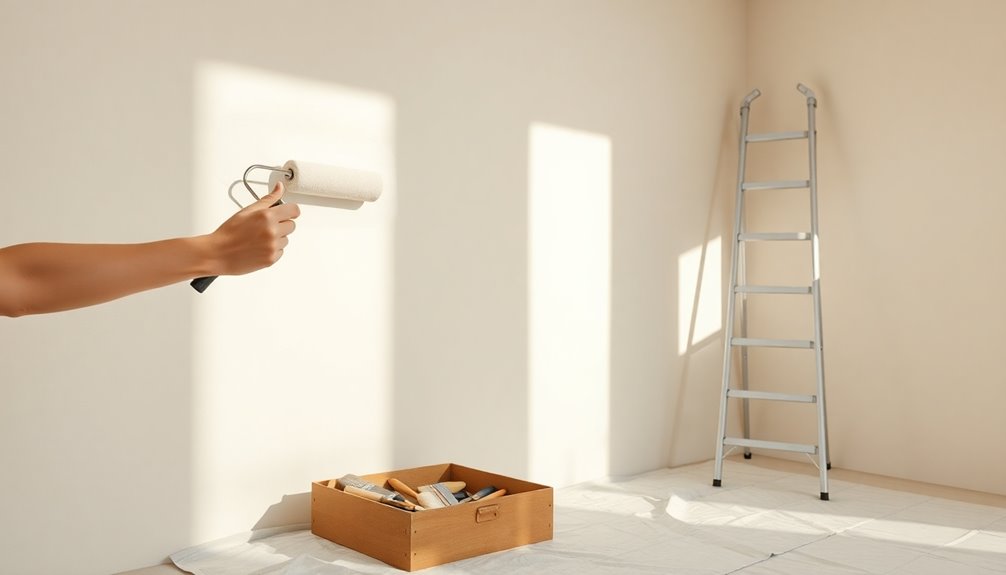To properly maintain your painted walls, start by choosing the right cleaning method based on your paint type. Prepping the area is essential; remove furniture and dust the walls thoroughly. Use a gentle mixture of mild soap and warm water to wash the walls, rinsing afterward to avoid residue. For tough stains or touch-ups, use leftover paint for consistency. Keeping a regular cleaning schedule will enhance your home's atmosphere, and there's even more to discover about efficient maintenance techniques.
Key Takeaways
- Regularly dust and clean walls to prevent dust buildup and maintain a fresh appearance.
- Use appropriate cleaning solutions based on the paint type to avoid damage.
- Rinse walls with plain water after cleaning to remove any residue.
- Touch up paint with the original color for consistency, blending edges carefully.
- Develop a regular cleaning schedule, especially in high-traffic areas, to prolong paint life.
Importance of Wall Maintenance

Maintaining your painted walls is essential, as regular upkeep not only prevents dust and grime buildup but also keeps your home looking fresh and inviting.
By incorporating wall cleaning into your routine, you guarantee that dirt and stains don't become ingrained, which can lead to costly repairs or even the need for repainting.
Clean walls enhance your home's aesthetic, creating a vibrant living space that reflects your care for your environment.
Furthermore, maintaining your painted surfaces promotes a healthier indoor atmosphere by reducing allergens and irritants that accumulate on surfaces.
Taking the time to clean and maintain your walls can greatly extend the life of the paint, keeping it looking fresh and intact for years to come.
Consider the Paint Type
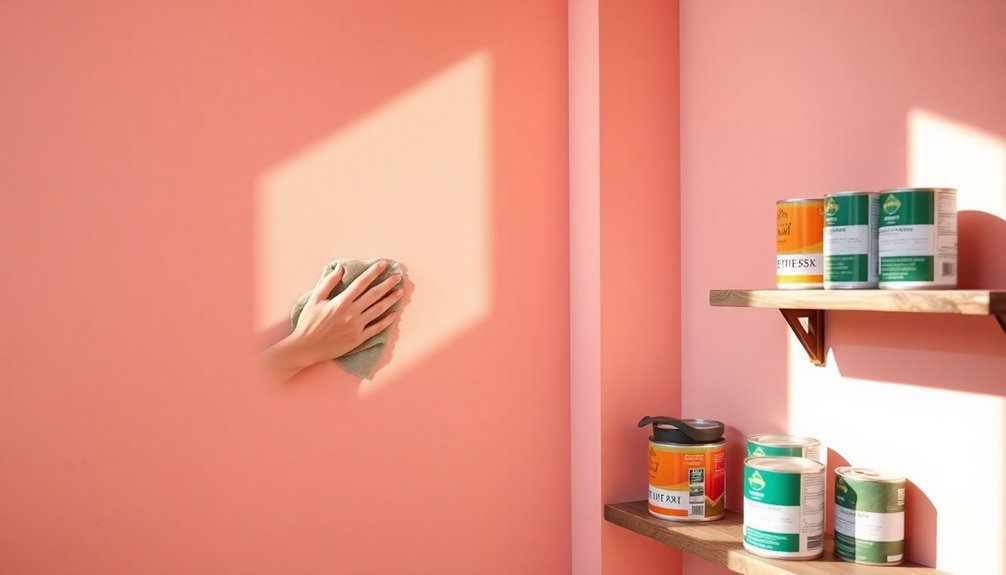
When considering how to care for your painted walls, it's important to recognize the type of paint used, as each has its own cleaning requirements.
If you have higher-gloss finishes like semi-gloss or gloss, you'll find that they're easier to clean with various cleaning solutions, resisting streaks and damage.
Conversely, if your walls are coated with flat paint, be careful; these finishes require gentle cleaning techniques to avoid scuffs or wear.
Always test your chosen cleaning solutions on a small, inconspicuous area first to verify compatibility with your paint type.
For areas prone to moisture, like kitchens and bathrooms, opting for oil-based paints can provide extra resilience against humidity and stains, making maintenance easier in the long run.
Prepping the Walls

Before diving into the cleaning process, it's crucial to prep your walls for the best results.
Start by preparing your cleaning area; remove paintings, lamps, and any other objects to avoid damage.
Next, grab a lambs wool duster or a vacuum with a bristle-brush attachment to remove dust, cobwebs, and loose dirt. This guarantees a clean surface for washing.
Always clean walls from the top down to prevent redistributing dust and dirt back onto already cleaned areas. Use a sturdy step stool or ladder to safely reach high spots.
Finally, lay down newspaper, drop cloths, or towels on the floor to catch any drips or debris during the wall cleaning process. This prep work makes a significant difference!
Wall-Cleaning Solutions
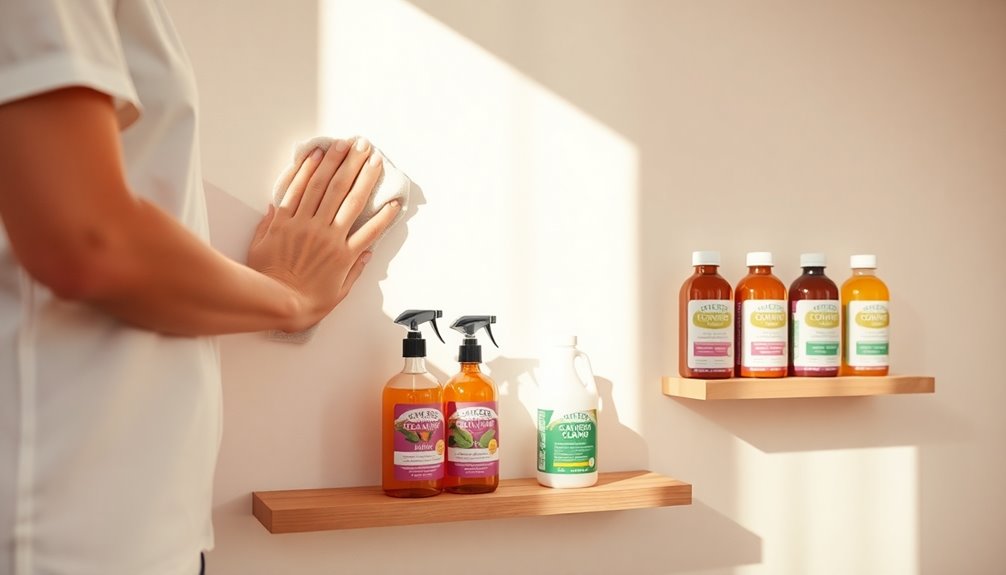
With your walls prepped and ready, it's time to explore effective wall-cleaning solutions. For general cleaning, plain water usually works, but a mixture of mild detergent and warm water can effectively remove dirt without damaging the paint.
You might also try vinegar diluted in water—just test it in an inconspicuous area first. Here are some options for your wall-cleaning arsenal:
- Mild soap and warm water
- Vinegar and water solution
- Specialized cleaning solutions for different finishes
- Baking soda paste for gentle stain removal
Always remember to rinse your walls with plain water after using any cleaning solution to eliminate residue, which can attract dirt later on.
Stick to gentle methods for the best results!
Removing Tough Stains

When it comes to removing tough stains from your painted walls, having the right techniques and cleaning solutions is key.
You can use simple ingredients like baking soda, vinegar, or even laundry borax to tackle those stubborn marks effectively.
Let's explore these methods to keep your walls looking fresh and clean.
Effective Stain Removal Techniques
Although tough stains on painted walls can be frustrating, there are effective techniques to restore their appearance.
Start with a paste made from baking soda and water for stubborn stains; gently apply it to lift the stain without damaging the paint. You can also use a vinegar-and-water solution, especially in kitchens and bathrooms where grease accumulates.
For particularly dirty walls, add laundry borax to enhance your cleaning mixture. When dealing with greasy stains, try a mild degreaser or a dish soap and water mix—just remember to test on a small area first.
- Use melamine sponges for scuff marks
- Test all cleaners cautiously
- Always remove any cleaner residue
- Keep your walls dry after cleaning
Cleaning Solutions to Use
Tackling tough stains on painted walls requires the right cleaning solutions to restore their appearance effectively. You can use a paste of baking soda and water to lift stubborn stains without harming the paint. A vinegar-and-water solution is another versatile option. For heavily soiled areas, consider adding laundry borax to enhance your cleaning power. In kitchens, gentle degreasers can help remove cooking residue and grease. Additionally, melamine sponges, like Mr. Clean Magic Erasers, work wonders on glossy finishes. Maintaining a clean environment can also reduce allergens and pollutants, contributing to better indoor air quality.
| Cleaning Solution | Best For |
|---|---|
| Baking Soda Paste | General stains |
| Vinegar-and-Water | Versatile cleaning |
| Gentle Degreasers | Kitchen grease |
Cleaning Method Based on Wall Finish

When it comes to cleaning your painted walls, the finish really matters.
Flat finishes need gentle care, while glossy finishes can handle tougher cleaning methods.
Plus, if you've just painted, make sure to wait at least two weeks before you start any cleaning to protect that fresh coat.
Flat Finish Cleaning Tips
To keep your flat-finished walls looking fresh, you'll want to approach cleaning with care. Flat finishes are less durable, so stick to mild detergents mixed with warm water.
Use a soft cloth or sponge, scrubbing in circular motions to minimize wear. Avoid abrasive cleaners or scrubbing pads, as they can damage the surface permanently.
Here are some tips for cleaning your painted walls:
- Always rinse with a well-wrung damp cloth to remove soap residue.
- For tough stains, consider a baking soda paste for gentle spot cleaning.
- Test any cleaner on a small area first.
- Regularly dust the walls to prevent dirt buildup.
Following these tips will help maintain the beauty of your flat finishes!
Glossy Finish Maintenance
While glossy finishes offer a sleek look and enhanced durability, maintaining their shine requires the right approach.
For cleaning walls with glossy finishes, mix warm water with a mild detergent. This combination effectively removes dirt and grease without damaging the surface.
When tackling tougher stains, use a melamine sponge, like a Mr. Clean Magic Eraser®, to gently scrub away scuff marks without scratching the paint.
Always rinse the walls thoroughly with plain water afterward to eliminate any detergent residue that could dull the finish.
While cleaning, scrub in circular motions to avoid streaking and preserve the wall's sheen.
With these simple steps, your glossy walls will remain vibrant and beautiful for years to come.
Newly Painted Precautions
After enjoying the shine of your glossy finishes, it's important to understand how to care for newly painted walls.
Avoid cleaning for at least two weeks to let the paint cure properly. Depending on the type of paint finishes, choose your cleaning methods wisely:
- For flat or matte finishes, use a mild detergent and water; don't scrub hard.
- Semigloss or glossy finishes can handle stronger cleaning solutions, including degreasers.
- Always test any cleaning solution on a small, hidden area first.
- Rinse thoroughly with plain water after cleaning to remove any residue.
Prepare the Room and Dust the Walls
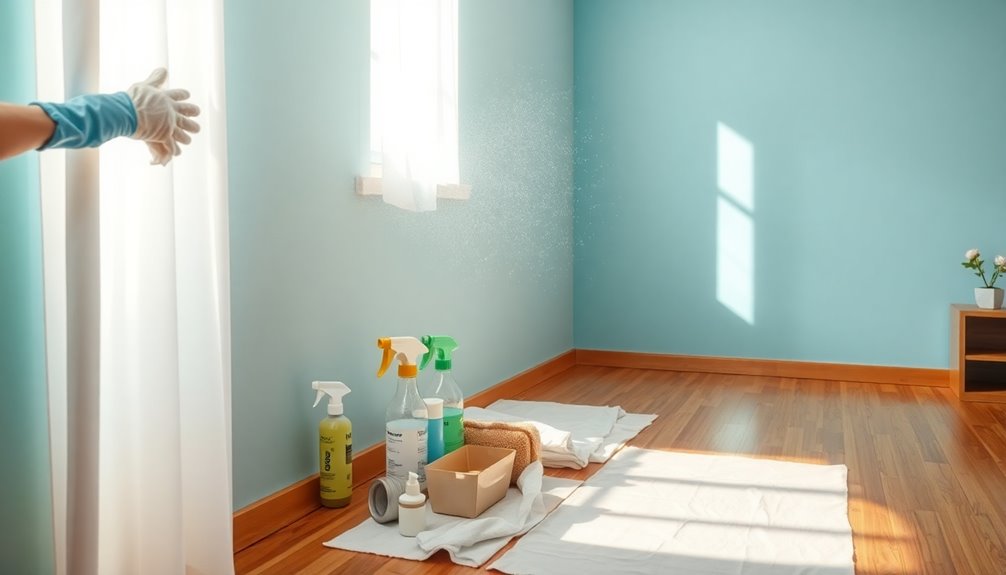
Before diving into the cleaning process, it's essential to prepare the room and make certain your walls are ready for maintenance. Start by removing paintings, lamps, and any other objects from the walls to prevent damage. Next, move furniture away, creating a gap to avoid scuffs and allowing ample space for cleaning.
Use a tack cloth or cheese cloth to dust the walls effectively, ensuring you reach high areas with a sturdy step stool or ladder. To catch any drips or debris, place newspaper, drop cloths, or clean towels on the floor. Additionally, consider using different materials for wall organization, as this can enhance both functionality and aesthetic appeal.
| Task | Purpose |
|---|---|
| Remove objects | Prevent damage |
| Move furniture | Create space for cleaning |
| Dust the walls | Remove dust and cobwebs |
| Use step stool/ladder | Reach high areas |
| Use drop cloths/towels | Catch drips and debris |
Wash the Walls
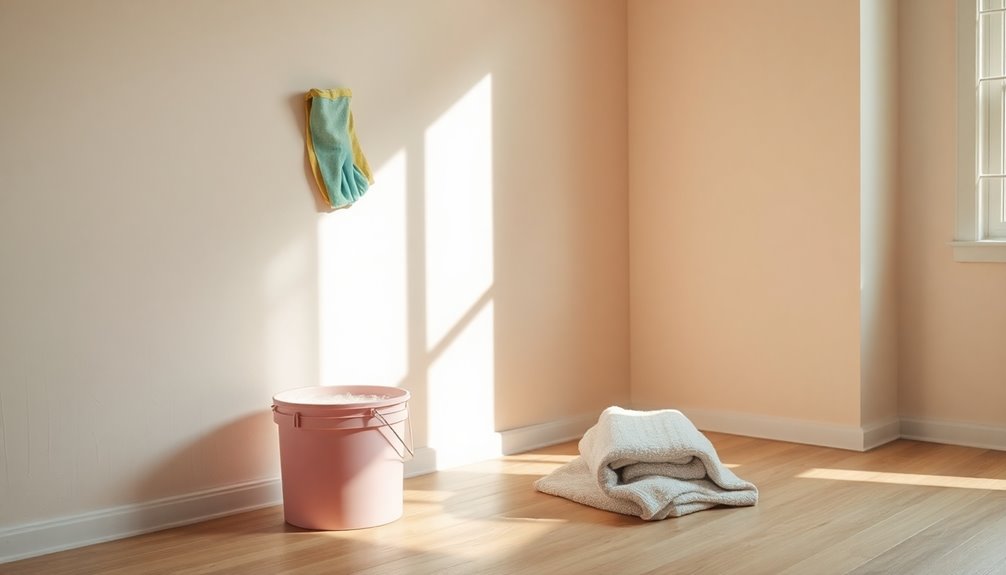
To effectively maintain your painted walls, start by washing them with a gentle mixture of mild soap and warm water.
Make sure the soap isn't too sudsy, as that can attract dirt. Use a soft cloth or sponge and scrub gently in circular motions to avoid damaging the paint finish. Always rinse the walls with a wet rag after washing to remove any soap residue that could cause discoloration over time.
- Wash walls more frequently in high-traffic areas.
- Wait at least two weeks after painting before washing.
- Use separate cloths for cleaning and rinsing.
- Test the soap mixture on a small, inconspicuous area first.
Following these steps will help you clean painted walls effectively and keep them looking fresh.
Touch up With Paint if Needed

Touching up your painted walls can restore their appearance and prolong their life. Use your leftover original paint for touch-ups; this guarantees color consistency and quality. Always stir the original paint thoroughly to achieve the best paint consistency. Apply the touch-up paint using the same method as the original application, whether it's a brush or roller. Feather-brush or gently roll the edges to blend the new paint seamlessly with the surrounding wall.
| Step | Description |
|---|---|
| 1. Check Paint | Confirm you have labeled touch-up paint. |
| 2. Stir Thoroughly | Blend settled pigments for uniformity. |
| 3. Apply Method | Use the same application method as before. |
| 4. Blend Edges | Feather-brush or roll for a seamless finish. |
Frequently Asked Questions
How Do You Maintain Painted Walls?
To maintain your painted walls, start by regularly dusting them with a vacuum and a dust brush or a microfiber cloth.
When it's time to clean, mix mild soap with warm water and use a soft cloth in circular motions. Rinse with a wet rag to avoid residue.
Address stains quickly with the right solutions, and keep a paint repair kit handy for touch-ups to guarantee your walls always look fresh and vibrant.
How Do You Protect Painted Walls?
To protect your painted walls, keep furniture a few inches away to avoid scuffs and scratches.
Clean up spills immediately to prevent stains from setting in.
Regularly dust your walls with microfiber cloths to avoid dirt buildup.
Don't forget to schedule routine cleaning for high-traffic areas like light switches and door knobs.
Finally, maintain a paint repair kit handy for quick touch-ups, ensuring your walls stay fresh and vibrant.
How Do You Prepare Already Painted Walls?
To prepare already painted walls, start by removing all decorations like frames and lamps, creating a clear surface for cleaning.
Dust the walls thoroughly, working from the top down to avoid spreading dirt.
Protect your floor with newspapers or drop cloths to catch any drips.
Move furniture away from the walls for easy access and check for any areas needing touch-ups or repairs before you begin the cleaning process.
How Long Do Painted Walls Last?
Painted walls typically last between 5 to 10 years, depending on factors like paint quality, finish type, and environmental conditions.
If you've used high-gloss or semi-gloss finishes, you can expect them to last longer due to their durability.
Areas with high traffic or moisture, like kitchens and bathrooms, might need more frequent repainting.
Regular cleaning and touch-ups can also help extend the life of your walls, giving you more time before a full repaint.
Conclusion
Maintaining your painted walls doesn't have to be a chore. By understanding your paint type and using the right cleaning methods, you can keep your walls looking fresh and vibrant. Remember to prep the room, dust the walls, and tackle any tough stains promptly. If you notice any scuffs or chips, a quick touch-up can work wonders. With a little care, your walls will shine and enhance the beauty of your space for years to come!
